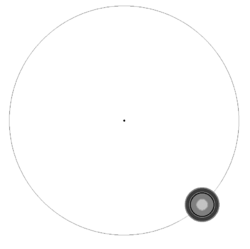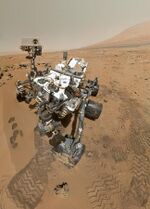Astronomy:V1400 Centauri
| Observation data Equinox J2000.0]] (ICRS) | |
|---|---|
| Constellation | Centaurus |
| Right ascension | 14h 07m 47.92976s[1] |
| Declination | −39° 45′ 42.7671″[1] |
| Apparent magnitude (V) | 12.2 - ~15.6[2] |
| Characteristics | |
| Evolutionary stage | pre-main sequence[3] |
| Spectral type | K5 IV(e) Li[3] |
| Variable type | rotational T Tau and eclipsing[2] |
| Astrometry | |
| Radial velocity (Rv) | 5.65±2.92[1] km/s |
| Proper motion (μ) | RA: −23.108±0.015[1] mas/yr Dec.: −21.048±0.017[1] mas/yr |
| Parallax (π) | 7.2351 ± 0.0140[1] mas |
| Distance | 450.8 ± 0.9 ly (138.2 ± 0.3 pc) |
| Details | |
| Mass | 0.9[3] M☉ |
| Radius | >0.93±0.02[4] R☉ |
| Luminosity | 0.34[1] L☉ |
| Surface gravity (log g) | 4.30[1] cgs |
| Temperature | 4400±100[5] K |
| Age | 16[3] Myr |
| Database references | |
| SIMBAD | data |
| Extrasolar Planets Encyclopaedia | data |
V1400 Centauri (also known as 1SWASP J140747.93−394542.6, J1407 and Mamajek's Object) is a pre-main-sequence star in the constellation Centaurus at a distance of about 451 light-years from Earth.[5][6] A relatively young star, its age is estimated to be 16 million years, and its mass is about 90% that of the Sun.[3][7] The star has a maximum apparent magnitude of 12.2 and requires a telescope to be seen. The star's name comes from the SuperWASP (Wide Angle Search for Planets) program and the star's coordinates.
In 2007, J1407 was observed to be eclipsed and orbited by at least one major body, 1SWASP J1407b[8] (J1407b), thought to be either a large gas giant planet or a brown dwarf, with an immense ring system.[3][5][9] Subsequent observations have not successfully detected J1407b, suggesting that it is on a highly eccentric orbit around the star.[4]
By 2021, it was discovered the parent star is strongly variable, with a 5.4-year long magnetic activity cycle, and no evidence was detected of additional planets or a repeat of the deep eclipses attributed to a transiting ring system.[10]
Variability
V1400 Centauri is the variable star designation of this star, assigned in 2015.[11] It is known to be a young star, not yet on the main sequence, and is classified as a T Tauri variable which shows variability as it rotates due to surface spots.[2] It also underwent a series of deep eclipse-like fadings in 2007 that have been ascribed to a ring system around a sub-stellar companion. These have not been repeated and the existence of a companion is still uncertain, pending a repeat of the eclipse.[10]
The rotation of the V1400 Centauri every 3.2 days causes regular brightness changes with an amplitude of about 0.1 magnitudes. The star is also intrinsically variable, as is common for pre-main-sequence stars, with a slow decrease in brightness being shown over the periods 2001 to 2007 and 2012 to 2020. The 2007 eclipse was up to three magnitudes in depth.[10]
Suspected substellar companion
File:J1407b.ogg The discovery of the J1407 system and its unusual eclipses were first reported by a team led by University of Rochester astronomer Eric Mamajek in 2012.[3] The existence and parameters of the ring system around the substellar companion J1407b were deduced from the observation of a very long and complex eclipse of the parent star lasting 56 days during April and May 2007.[3][7] The low-mass companion J1407b has been referred to as a "Saturn on steroids"[6][13] or "Super Saturn"[14] due to its massive system of circumplanetary rings with a radius of approximately 90 million km (0.6 AU).[5] The orbital period of J1407b is estimated to be around a decade (3.5 to 13.8 years or 3825 days), and its most probable mass is approximately 13 to 26 Jupiter masses which would make the companion a brown dwarf, but with considerable uncertainty.[5] The ringed body can be ruled out as being a star with mass of over 80 Jupiter masses at greater than 99% confidence.[5] The ring system has an estimated mass similar to that of the Earth.[9] A major gap in the rings at about 61 million km (0.4 AU) from its center is considered to be indirect evidence of the existence of a shepherd exomoon with mass up to 0.8 Earth masses.[5][15]
J1407b is the first exoplanet or brown dwarf discovered with a ring system by the transit method. A sequence of occultations (eclipses) of the star occurred over a 56-day period in 2007. The pattern was consistent with that expected for the transit of a large array of multiple rings, indicating the substellar companion dubbed "J1407b".[3] The J1407b ring system has an outer radius of approximately 90 million km (about 640 times the extent of Saturn's rings).[16] Cleared gaps in the rings indicate satellites ("exomoons") have accreted from denser rings. The young age of the stellar system (about 16 million years) and the high mass of the ring system (roughly an Earth mass) are more consistent with it being an early (proto-)exomoon or moons, rather than a long-term stable ring system in an evolved planetary system (such as Saturn's rings).
J1407b has not been observed since its transit in 2007, suggesting that it is on a highly eccentric orbit around the star.[4] Such an orbit could disrupt the ring system of J1407b.[6] Dynamical simulations run by astronomers Steven Rieder and Matthew Kenworthy indicate that in order for J1407b's ring system to be stable, the rings must orbit J1407b in a retrograde motion, opposite to the direction J1407b orbits its host star.[4][6] This retrograde solution for the ring system of J1407b allows for longer ring lifetimes as well as further constraints to the age of the ring system.[4] The rings may be replenished over timescales as a result of processes that produce additional debris around J1407b, such as the tidal disruption of comets.[4]
Alternatively, J1407b may also not be bound to J1407. The previous explanation involving J1407b orbiting J1407 would have J1407b as a brown dwarf companion with a large, Hill sphere filling ring system. However, issues with the stability of any rings combined with the lack of detection of another eclipse, suggests that J1407b may not be bound to J1407.[17] No other deep eclipses has been found in the data spanning from 1890 to 1990, nor in recent time-series photometry from 2012-2018. A significant proportion of orbital periods for J1407b from 5 to 20 years can be disregarded, therefore if there is an actual orbital period it is likely outside of this range.[17]
From Earth's point of view, the ring system of J1407b would have an angular diameter of about 3.7 milliarcseconds across. For comparison, if Saturn were as many light years away, its rings in full breadth would be 0.006 milliarcseconds across,[1] and the diameter of Pluto from earth varies between 60 and 110 milliarcseconds across.[18]
| Companion (in order from star) |
Mass | Semimajor axis (AU) |
Orbital period (days) |
Eccentricity | Inclination | Radius |
|---|---|---|---|---|---|---|
| b (unconfirmed) | 20.0±6.0 MJ | 3.9±1.7 | 3725±900 | >0.6 | — | — |
No additional transits from Jupiter-sized or larger planets were discovered in a 21-year long observational series by 2023.[10]
See also
- List of stars that have unusual dimming periods
Notes
- 1.^ J1407b ring system diameter = 0.0000190 ly; distance = ~439 ly. 0.0000190/439=0.000000043 of the sky; 0.00000104 degrees; 0.000062 arcminutes; 0.00374 arcseconds; 3.74 milliarcseconds
Saturn's main ring system diameter (D-F rings) = 0.0000000296 ly; distance = 439 ly. 0.0000000296/439=0.0000000000674 of the sky; 0.00000000162 degrees; 0.000000097 arcminutes; 0.00000583 arcseconds; 0.00583 milliarcseconds
References
- ↑ 1.0 1.1 1.2 1.3 1.4 1.5 1.6 Vallenari, A. et al. (2022). "Gaia Data Release 3. Summary of the content and survey properties". Astronomy & Astrophysics. doi:10.1051/0004-6361/202243940 Gaia DR3 record for this source at VizieR.
- ↑ 2.0 2.1 2.2 "V1400 Cen". AAVSO. https://www.aavso.org/vsx/index.php?view=detail.top&oid=283111.
- ↑ 3.0 3.1 3.2 3.3 3.4 3.5 3.6 3.7 3.8 3.9 Mamajek, Eric E.; Quillen, Alice C.; Pecaut, Mark J.; Moolekamp, Fred; Scott, Erin L.; Kenworthy, Matthew A.; Collier Cameron, Andrew; Parley, Neil R. (March 2012). "Planetary Construction Zones in Occultation: Discovery of an Extrasolar Ring System Transiting a Young Sun-like Star and Future Prospects for Detecting Eclipses by Circumsecondary and Circumplanetary Disks". The Astronomical Journal 143 (3): 72. doi:10.1088/0004-6256/143/3/72. Bibcode: 2012AJ....143...72M.
- ↑ 4.0 4.1 4.2 4.3 4.4 4.5 Rieder, Steven; Kenworthy, Matthew A. (21 November 2016). "Constraints on the size and dynamics of the J1407b ring system". Astronomy & Astrophysics 596 (A9): A9. doi:10.1051/0004-6361/201629567. Bibcode: 2016A&A...596A...9R.
- ↑ 5.0 5.1 5.2 5.3 5.4 5.5 5.6 Kenworthy, Matthew A.; Mamajek, Eric E. (January 22, 2015). "Modeling giant extrasolar ring systems in eclipse and the case of J1407b: sculpting by exomoons?". The Astrophysical Journal 800 (2): 126. doi:10.1088/0004-637X/800/2/126. Bibcode: 2015ApJ...800..126K.
- ↑ 6.0 6.1 6.2 6.3 St. Fleur, Nicholas (October 13, 2016). "Distant Ringed Object Could Be 'Saturn on Steroids'". New York Times. https://www.nytimes.com/2016/10/14/science/exoplanet-rings-saturn-j1407b.html.
- ↑ 7.0 7.1 "Eclipsing Ring System J1407". Cerro Tololo Inter-American Observatory. June 22, 2012. http://www.ctio.noao.edu/noao/content/Eclipsing-Ring-System-J1407.
- ↑ 8.0 8.1 "The Extrasolar Planet Encyclopaedia — 1SWASP J1407 b". Extrasolar Planets Encyclopaedia. 2014-10-29. https://exoplanet.eu/catalog/1swasp_j1407_b--2330/.
- ↑ 9.0 9.1 "Gigantic ring system around J1407b much larger, heavier than Saturn's". University of Rochester. January 26, 2015. http://www.eurekalert.org/pub_releases/2015-01/uor-grs012615.php.
- ↑ 10.0 10.1 10.2 10.3 Barmentloo, S.; Dik, C.; Kenworthy, M. A.; Mamajek, E. E.; Hambsch, F.-J.; Reichart, D. E.; Rodriguez, J. E.; Van Dam, D. M. (2021), "A search for transiting companions in the J1407 (V1400 Cen) system", Astronomy & Astrophysics 652: A117, doi:10.1051/0004-6361/202140768
- ↑ Kazarovets, E. V; Samus, N. N; Durlevich, O. V; Kireeva, N. N; Pastukhova, E. N (2015). "The 81st Name-List of Variable Stars. Part I - RA 00h to 17h30". Information Bulletin on Variable Stars 6151: 1. Bibcode: 2015IBVS.6151....1K.
- ↑ "Search SuperWASP Time Series". NASA. https://exoplanetarchive.ipac.caltech.edu/cgi-bin/TblSearch/nph-tblSearchInit?app=ExoTbls&config=superwasptimeseries.
- ↑ O'Neill, Ian (January 12, 2012). "'Saturn on Steroids' Exoplanet Discovered?". Discovery News. http://news.discovery.com/space/saturn-on-steroids-exoplanet-discovered-120111.htm.
- ↑ Gigantic ring system around J1407b much larger, heavier than Saturn's, on University of Rochester website.
- ↑ 15.0 15.1 Sutton, P. J. (2019). "Mean motion resonances with nearby moons: an unlikely origin for the gaps observed in the ring around the exoplanet J1407b". Monthly Notices of the Royal Astronomical Society 486 (2): 1681–1689. doi:10.1093/mnras/stz563. Bibcode: 2019MNRAS.486.1681S.
- ↑ Brumfield, Ben (2015-01-28). "Discovery: 'Super Saturn' with rings 200 times as big". CNN.com. http://www.cnn.com/2015/01/28/tech/giant-planetary-ring-system/index.html.
- ↑ 17.0 17.1 Mentel, R. T.; Kenworthy, M. A.; Cameron, D. A.; Scott, E. L.; Mellon, S. N.; Hudec, R.; Birkby, J. L.; Mamajek, E. E. et al. (November 2018). "Constraining the period of the ringed secondary companion to the young star J1407 with photographic plates". Astronomy & Astrophysics 619: A157. doi:10.1051/0004-6361/201834004. ISSN 0004-6361.
- ↑ Pluto Fact Sheet, NASA
External links
- Extrasolar Planet Encyclopedia page on J1407b, (Accessed January 29, 2015)
- Exoring model for J1407b, on Vimeo.
- 'Saturn on Steroids': 1st Ringed Planet Beyond Solar System Possibly Found
- Eric Mamajek's webpage at University of Rochester
 |





